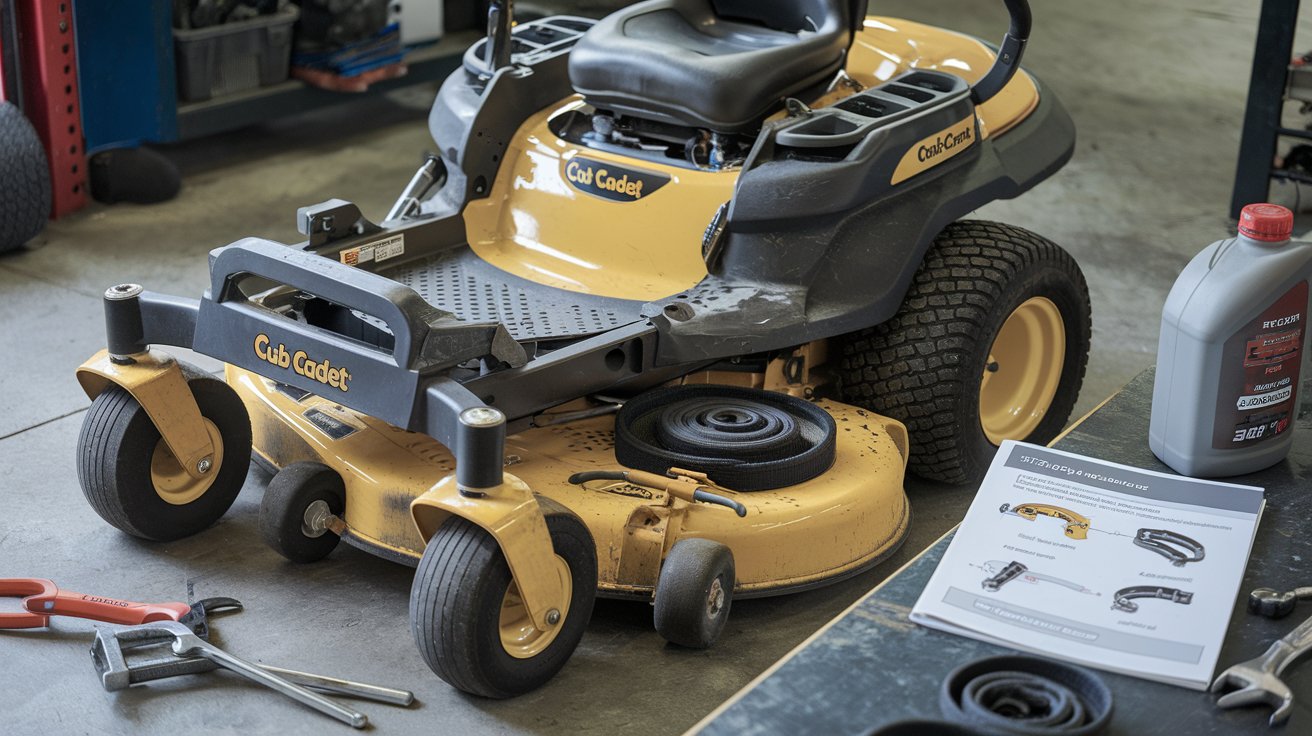When your Cub Cadet zero-turn mower faces the issue of one side not working, it can hinder your mowing efficiency. This guide provides a step-by-step troubleshooting approach, covering essential checks like hydraulic fluid levels, drive belts, pulleys, and hydraulic pumps. Regular preventive maintenance tips such as fluid checks, cleaning routines, and scheduled inspections help avoid future problems. Additionally, knowing when to seek professional help for complex repairs or warranty considerations ensures your mower stays in top shape. For those looking to enhance their mower’s performance, various upgrades and modifications can extend its lifespan and improve comfort.
Wondering how to keep your Cub Cadet running like new and avoid costly repairs? Dive into our detailed guide for practical tips and solutions that can save you time and money while ensuring your mower performs at its best!
This guide dives deep into understanding the mechanics behind these mowers, identifying common causes for one-side failure, and providing practical solutions to get your mower back in action.
Understanding Zero-Turn Mower Mechanics
Basic Components of a Zero-Turn Mower
- Frame and Deck: The structural foundation that houses all components.
- Engine: Powers the mower and drives the hydrostatic system.
- Hydrostatic Transmission: Consists of pumps and motors that control wheel movement.
- Wheels: Two rear drive wheels independently controlled for turning.
How the Dual Hydrostatic Drive System Works
The dual hydrostatic drive system is the heart of a zero-turn mower’s functionality. Each rear wheel is driven by its own hydraulic pump and motor, allowing independent speed control. This system enables the mower to pivot around a central point, providing the “zero-turn” capability.
Importance of Balanced Operation
Balanced operation is crucial for smooth performance. When both sides of the drive system work in harmony, the mower moves straight and responds correctly to directional controls. Any imbalance can lead to one side not functioning, affecting the mower’s maneuverability.
Common Causes of One-Side Not Working
Hydraulic Fluid Issues
- Low Hydraulic Fluid Levels: Can lead to insufficient pressure for one side.
- Contaminated Fluid: Dirt or water in the hydraulic fluid can impair system performance.
- Air in the System: Can cause erratic behavior and reduced power on one side.
Drive Belt Problems
- Worn or Broken Belt: A damaged belt can slip or break, stopping one wheel.
- Misaligned Belt: Incorrect belt positioning can cause uneven power distribution.
Damaged or Worn Pulleys
- Cracked or Bent Pulleys: Can lead to uneven belt tension.
- Worn Pulley Bearings: Cause resistance and affect one side’s operation.
Faulty Hydraulic Pump
- Pump Wear and Tear: Over time, pumps can degrade, losing efficiency.
- Internal Leaks: Can reduce the pressure needed to drive one wheel.
Electrical System Malfunctions
- Loose or Damaged Wiring: Can interrupt signals to the hydraulic system.
- Faulty Solenoids: Responsible for controlling hydraulic fluid flow.
- Dead or Weak Battery: Can lead to insufficient power for the control system.
Diagnosing the Problem
Visual Inspection Techniques
- Check for Leaks: Inspect hydraulic hoses and fittings for fluid leaks.
- Examine Belts and Pulleys: Look for signs of wear, cracks, or misalignment.
- Inspect Electrical Connections: Ensure all wires and connectors are secure and free of corrosion.
Testing Hydraulic Pressure
- Use a Pressure Gauge: Attach it to the hydraulic system to check for adequate pressure.
- Compare Both Sides: Uneven pressure readings indicate issues in the weaker side.
Checking Electrical Connections
- Multimeter Testing: Use a multimeter to test voltage and continuity in the wiring.
- Inspect Switches and Relays: Make sure they are functioning correctly and not causing interruptions.
Assessing Mechanical Components
- Rotate the Pulleys by Hand: Feel for resistance or wobbling.
- Check Wheel Motors: Ensure they rotate freely without unusual noise or resistance.
Troubleshooting Summary Table
| Issue | Symptom | Solution |
| Low Hydraulic Fluid | One side weak or not moving | Refill fluid and bleed air from the system |
| Worn Drive Belt | No power to one wheel | Replace the belt |
| Damaged Pulleys | Uneven movement, noise | Replace damaged pulleys and bearings |
| Faulty Hydraulic Pump | Reduced power or no movement | Repair or replace the pump |
| Electrical Malfunctions | Inconsistent control, no response | Repair wiring, replace faulty components |
By understanding and addressing these common issues, you can maintain your Cub Cadet zero-turn mower’s efficiency and extend its lifespan. Regular maintenance and prompt troubleshooting are key to avoiding downtime and ensuring your mower performs at its best.
Step-by-Step Troubleshooting Guide
Inspecting and Replacing Hydraulic Fluid
- Check Fluid Levels: Low hydraulic fluid is a common cause. Use the dipstick to check the levels and top up if necessary.
- Replace Old Fluid: If the fluid is dirty or old, it can impede the system. Drain the old fluid and refill with the recommended type.
| Symptom | Cause | Solution |
| Low fluid level | Leak or evaporation | Refill with fresh hydraulic fluid |
| Dirty fluid | Contaminants in the system | Drain and replace fluid |
Examining and Adjusting Drive Belts
- Inspect for Wear: Look for cracks, frays, or slack in the belts.
- Tighten or Replace: A loose or worn belt can cause uneven power distribution. Adjust the tension or replace the belt if necessary.
Cleaning or Replacing Pulleys
- Check for Obstructions: Dirt and debris can accumulate on the pulleys, affecting their performance.
- Clean or Replace: Use a brush to clean the pulleys or replace them if they’re damaged.
Testing and Repairing Hydraulic Pumps
- Check Pump Function: If other components are fine, the hydraulic pump might be the culprit.
- Test and Repair: A malfunctioning pump requires testing by a professional or replacement if it’s beyond repair.
Preventive Maintenance Tips
Regular Fluid Checks and Changes
- Routine Inspections: Check hydraulic fluid levels weekly.
- Scheduled Changes: Replace hydraulic fluid as per the manufacturer’s guidelines to ensure optimal performance.
Proper Cleaning and Storage Practices
- Cleaning Routine: After each use, clean your mower to remove grass clippings and debris.
- Storage: Store the mower in a dry, sheltered place to protect it from the elements.
Scheduled Component Inspections
- Belt and Pulley Checks: Inspect belts and pulleys monthly.
- Hydraulic System Checks: Periodically check the entire hydraulic system for signs of wear or leaks.
When to Seek Professional Help
Complex Hydraulic System Repairs
- Beyond DIY: If troubleshooting doesn’t fix the issue, professional diagnosis is necessary.
- Hydraulic Expertise: Complex repairs, especially involving the hydraulic pump, should be handled by trained technicians.
Major Electrical Issues
- Electrical Diagnosis: Problems with the mower’s electrical system often require specialized tools and expertise.
- Safety First: Avoid DIY fixes for electrical issues to prevent injury or further damage.
Warranty Considerations
- Check Warranty: If your mower is under warranty, repairs might be covered.
- Authorized Repairs: Ensure repairs are done by authorized service providers to maintain warranty validity.
Upgrading Your Cub Cadet Zero-Turn
Performance-Enhancing Modifications
- Upgrade Parts: Consider upgrading to high-performance parts like heavy-duty belts and pulleys for better durability.
- Advanced Hydraulics: Invest in superior hydraulic components to enhance overall performance.
Comfort and Convenience Add-Ons
- Seat Upgrades: Install a more comfortable seat for longer mowing sessions.
- Accessory Kits: Add cup holders, tool racks, or even LED lights to enhance your mowing experience.
Extending the Lifespan of Your Mower
- Regular Upkeep: Stick to a maintenance schedule to prolong your mower’s life.
- Timely Upgrades: Replace worn-out components promptly to avoid larger issues.
By following this guide, you can address the common issue of one side not working in your Cub Cadet zero-turn mower and keep it running smoothly. Regular maintenance and timely repairs are key to a long-lasting mower. If you have any specific experiences or tips to share, we’d love to hear from you!

